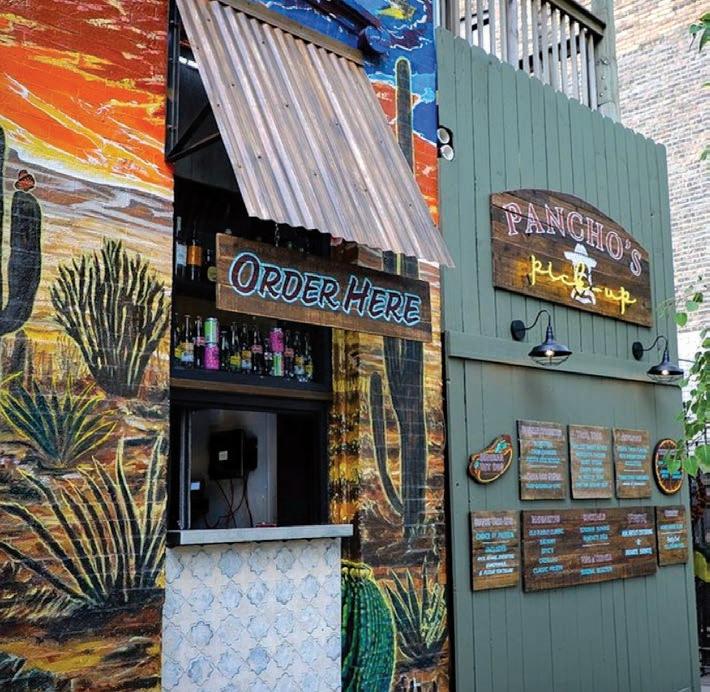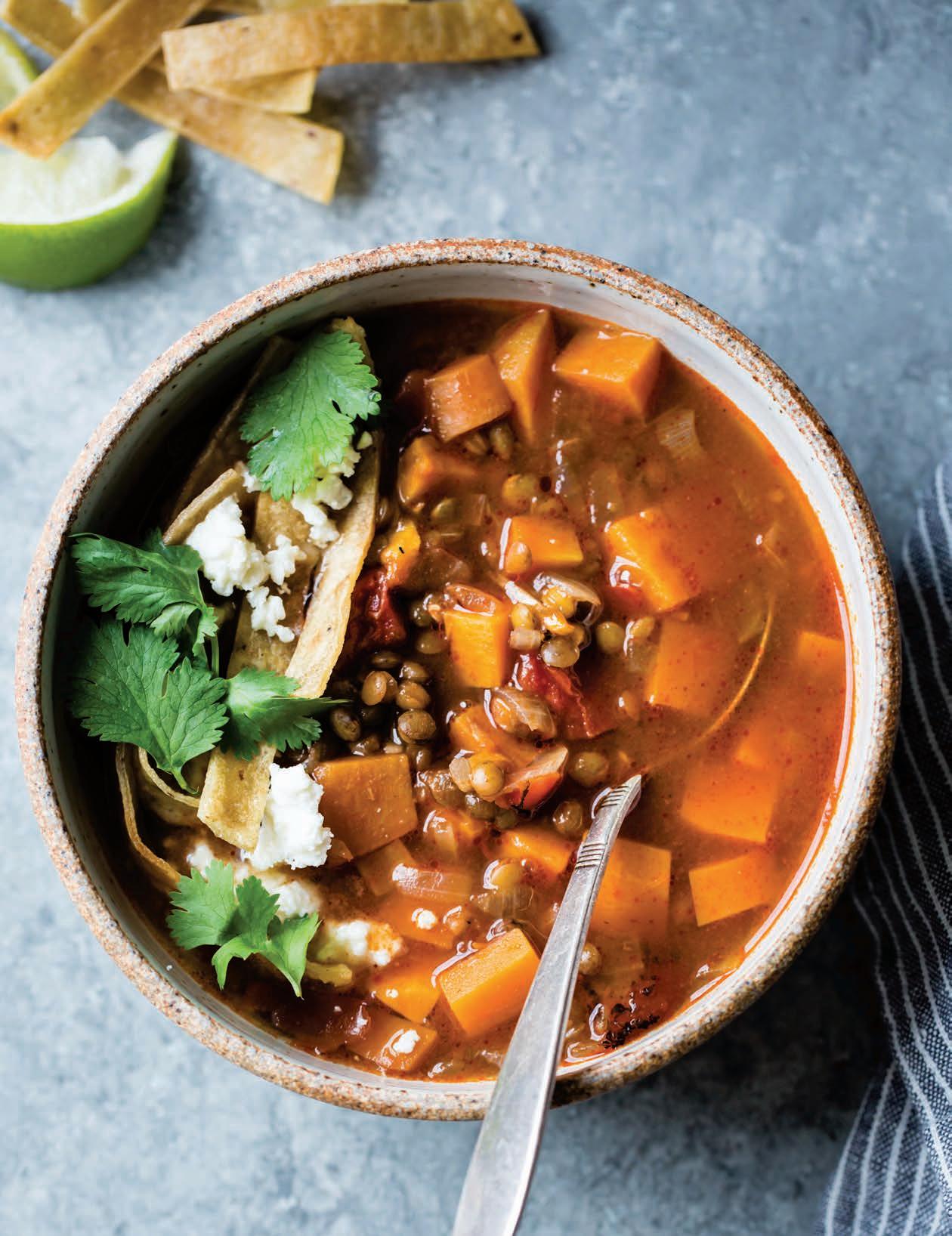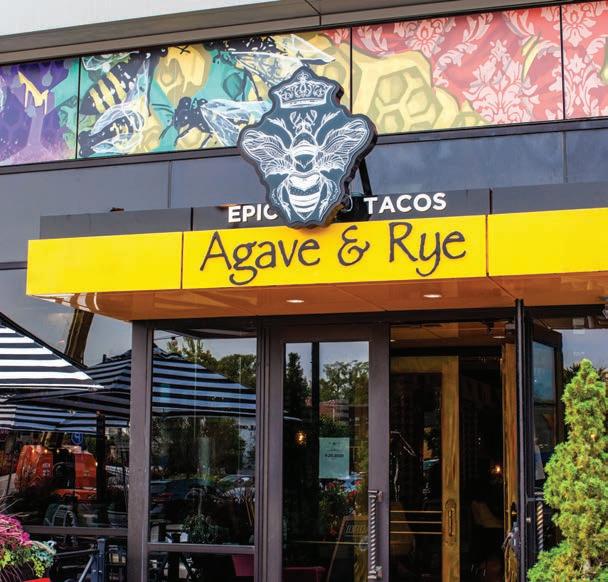
20 minute read
AT THE BAR—Hot Cocktails Fire Up Sales
| BY ELYSE GLICKMAN | Yes, Virginia, there is life after the holidays—along with more reasons for your customers to savor heated cocktails.
Hot versions of favorite bar drinks are poised for a comeback in 2021, according to “Do The Hustle,” a report about 2021 food, beverage and hospitality trends from af&co and Carbonate. That report, which says classics like the Hot Toddy, Hot Buttered Rum and Irish Coffee will outlast the holidays, also predicts creative new cocktails that incorporate hot tea, mulled wine, cider and coffee will emerge.
And their popularity won’t depend on the weather, industry pros say.
“As people are going to be outdoor dining year-round for the indefinite future, I think hot cocktails will be a welcome presence along with heaters and heat lamps,” says bartender and Licor 43 brand ambassador Mike Nardelli. “[And] after a long day at the beach surfing or paddle boarding any time of year, one of my favorite things to do is go into a local watering hole and have a hot toddy before I head home just to warm up,” he adds.
“While cool weather is the best sales pitch for a warm drink, if the season does not match the simple sell, there are other reasons [to order a hot cocktail],” echoes Hayden Miller, head bartender for Bodega Taqueria y Tequila i n Miami, Florida. “Although I relocated from the Midwest to South Florida, where the difference in climate is noticeable, there is something special and evocative about a warm cup of something wonderful on a cool patio.”
Bar master Manny Hinojosa, global brand ambassador for Tequila Cazadores and Tequila Corzo, also believes adding seasonal ingredients and flavors can prompt customers to rediscover warm cocktails any time of year. “In a fine dining Mexican restaurant setting, a warm drink made with seasonal fruit can be a lovely alternative to a dessert, especially if the diner doesn’t want to end the meal with something heavy,” Hinojosa says. “[A] warm peach and ginger toddy also pairs beautifully with familiar desserts like flan. In the spring or summer, the beautiful spices in the drink, along with a seasonal fruit, can take the chill out of a spring evening, or actually cool one off in the summer.”
The Hot Apple & Orange Toddy and Hot Chai Spice are examples of other hot cocktails Hinojosa has created.
NEW TWISTS ON TRADITIONAL BEVERAGES
Mexican and Latin restaurants—long go-to destinations
The heat is on HOT COCKTAILS FIRE UP BAR SALES
Manny Hinojosa’s Hot Apple & Orange Toddy (right) and Hot Chai Spice (below)
PHOTOS COURTESY OF PERFECT PUREE
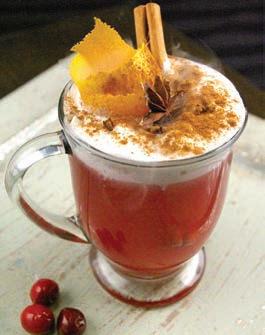
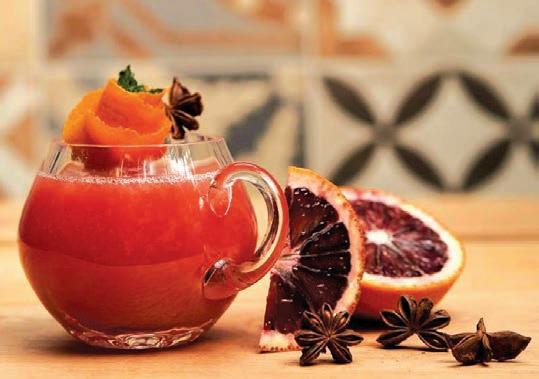
—MANNY HINOJOSA, global brand ambassador, Tequila Cazadores and Tequila Corzo
for icy Margaritas, Palomas and Mojitos—already have the ingredients and flavor profiles to create compelling warm cocktails.
And their options go beyond inventive riffs on hot coffee drinks, according to Nardelli, who says bartenders can use traditional, non-alcoholic Mexican drinks as starting points. Nardelli’s colleague Juan Martinez, for example, has jazzed up champurrado—a thick, warm chocolate-based atole made with masa harina, piloncillo, and water or milk—with Licor 43. Another example Nardelli has seen popping up in Los Angeles restaurants is the quintão, a traditional Brazilian grog made with cachaça and spiced cider.
Ponche—a hot fruit punch typically served during the holidays in Mexico—is another example. Chef Sergio Remolina, vice president of culinary for Taco Cabana in Dallas, says childhood memories of drinking ponche inspired him to create a cocktail version for Taco Cabana. Remolina’s version starts with a base of black tea to balance out the sweetness that comes from the fruit in the cocktail.
“We wanted to create a version of the ponche that not only speaks to holiday season festivities but also what things are actually in season in Mexico through the winter months,” Remolina explains. “Our recipe includes guava, cinnamon, orange peel as well as fruits more commonly found in Mexico, such as tejocotes (crab apples) and tamarind pods.”
In addition to the Rum Tea Ponche, Taco Cabana also offers Café de Olla—both “rooted in Mexican traditions,” Remolina says. “You’ll find Café de Olla, traditionally made in a clay pot sweetened with piloncillo, served in Mexico all year-round. It has found its way into Texas, where it is served throughout the winter months.”
“The Café de Olla also works great in the morning,” adds Chef Chelsea Lietz, corporate chef for Taco Cabana, who says that’s important to note since people are spending more time at home and ordering brunch to go this year. In addition to offering “the comforting aspect of the heat,” Lietz notes that adding ingredients like fresh fruit and spices the way Taco Cabana does makes hot cocktails “a new experience for many of our customers who did not grow up with Mexican traditions.”
SPIRITED CHOICES
Ivan Vasquez, owner of Los Angeles’ Madre Oaxacan Restaurant & Mezcaleria, embraces the chance to craft hot cocktails that use popular spirits in creative new ways. Take mezcal, a current customer
The Agave Hot Toddy from Madre Oaxacan Restaurant & Mezcaleria favorite: Vasquez uses it in his Agave Hot Toddy, a cocktail he believes will catch on “because of everything that makes it different from other mezcal drinks being served right now.”
This decidedly “different” cocktail is made with a threetimes distilled mezcal, tea Vasquez imports from Oaxaca, plus cinnamon, honey and a slice of lemon. “The way the mezcal is made is not too smoky [so it] allows the natural flavors of the tea to shine through,” Vasquez explains. “It’s also a great way for customers who love mezcal to experience it hot, and in a way they have not tried before.”
In addition to mezcal partnering well with tea, Bodega Taqueria y Tequila’s Miller says some gins and softer whiskies also are good backdrops for botanicals with hints of citrus. He also likes Mexican rums as a base, as they open “a window of funky flavors to experiment with, [as well as] the savory notes from other bottlings.”
Hot coffee also pairs well with mezcal, notes Vasquez, who says staff members sometimes suggest hot coffee with a shot of mezcal—just the way it’s served in Oaxaca. “With customers who don’t like mezcal, we can offer the Oaxacan coffee with a shot of tequila or whiskey added and start a conversation about the ingredients of the finished cocktails,” he adds. (continued on page 34)
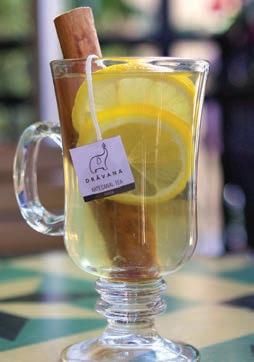
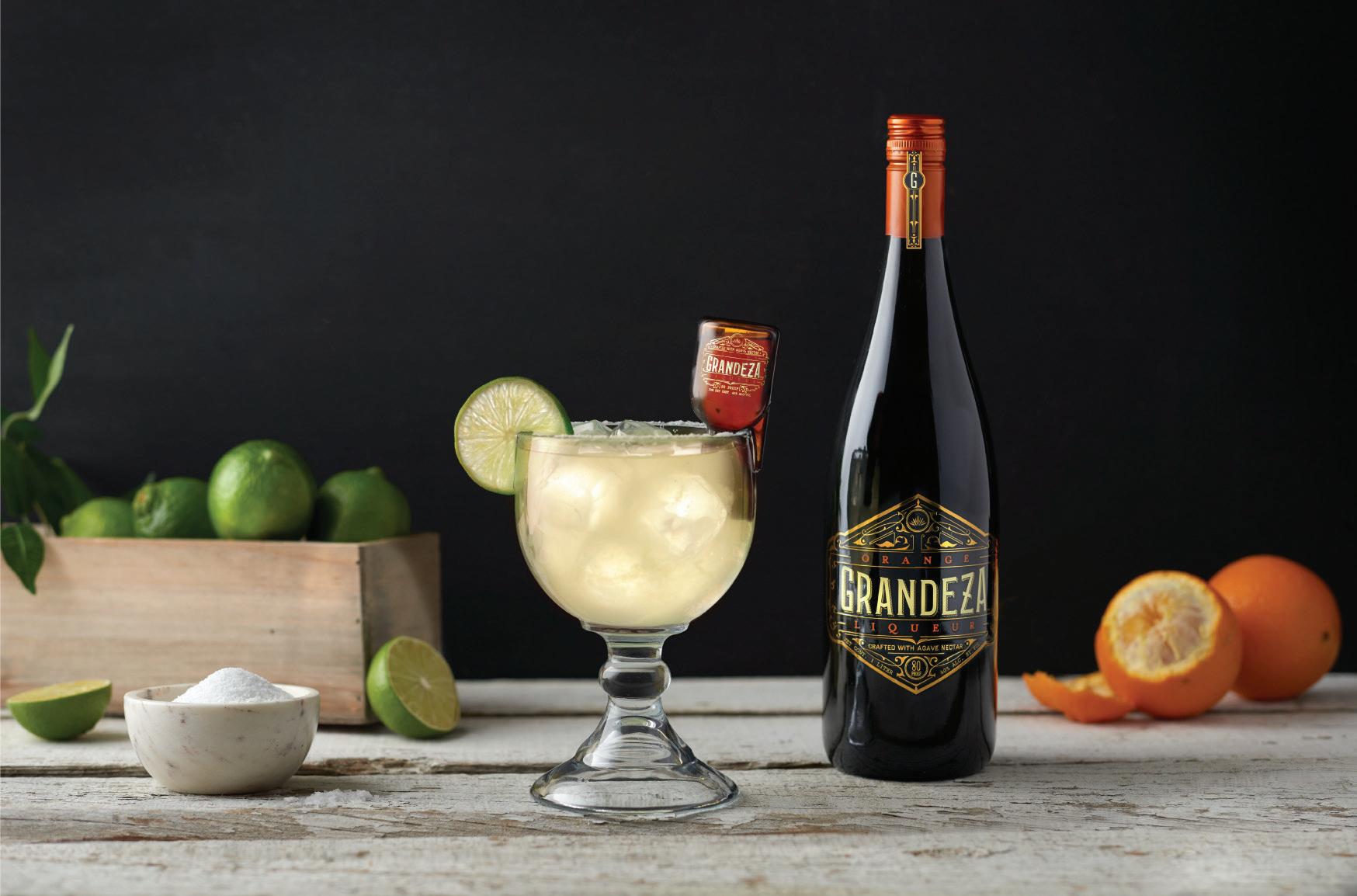

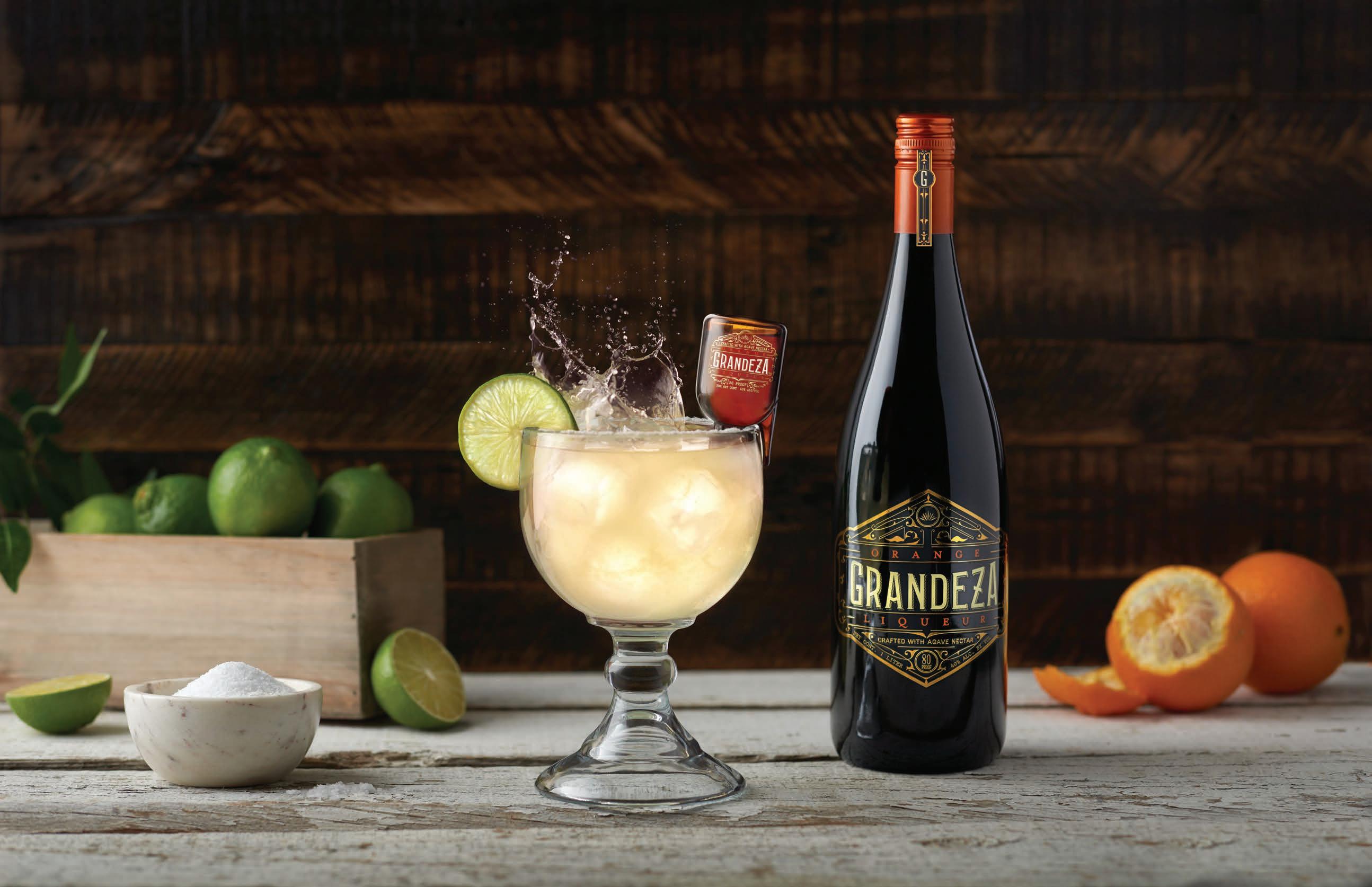

A PRIMER ON TO-GO COCKTAIL PREP
With to-go cocktails becoming a way of life for restaurants during this era of COVID-19, it’s important to know how to best prepare and package all of the cocktail ingredients. Here, Manny Hinojosa, global brand ambassador for Tequila Cazadores and Tequila Corzo, explains how to make the experience a safe and tasty one for customers who order hot cocktails for at-home consumption.
“You have to package the drink for to-go orders using two different containers. One will contain the spirit-based ingredients such as the base tequila, rum or whiskey along with additional spirits or liqueurs. The other will hold the nonalcoholic parts of the mix,” Hinojosa says. “Supply the customer with verbal and printed instructions, cautioning them not to heat the alcohol. The only thing that should be reheated is the mix in a microwave-safe coffee mug, and for only the period of time written in the instructions. After about 30 seconds, the customer can add the liquor portion and enjoy.”
ALTERNATIVES TO CREAM
Many hot cocktails—especially coffee-based creations—rely on dairy products for smoothness and flavor. But using dairy-based ingredients can create challenges: they aren’t shelf-stable and often impart a heaviness many customers no longer enjoy.
“We tried to create a warm cocktail with Oaxacan coffee and our house-made whipped cream,” says Vasquez. “While the final result was great, it was too labor-intensive, and we found out that the whipped cream expired after a day. Because of the necessity to keep things fresh, our recipes have to be simpler, with less sugar and heaviness.”
And as Miller notes, heavy drinks made with cream and alcohol are usually a harder sell beyond dessert.
One new trend brewing in that space is a move toward plant-based dairy alternatives.
At Sobre Mesa in Oakland, California, for example, the Cremosa de Cocoa cocktail blends spiced rum, red wine, sweet potato liqueur, chocolate, toasted marshmallow, ginger, and [non-dairy] coconut crema.
CONCENTRATES, INFUSIONS AND SPICES
For bars looking to reconcile quality and convenience in their to-go offerings, Miller suggests preparing a concentrate from tea to make your syrup and simply introducing a lower temperature water to the cocktail. “This ensures you will not be over-heating the spirit, giving the nose too much bite from fumes while still incorporating your tea flavors,” he says.
With availability and cost of fresh ingredients also a major concern, some establishments are turning to shelf-stable cordials, shrubs and fruit purees to create seasonal creations, especially in times where togo drinks are the rule. Nardelli says tea-infused spirits and tea-based ingredients are becoming more commonplace to achieve fresh flavored cocktails, either hot or cold.
“There’s a lot of versatility when you get into infusions in base spirits,” Nardelli explains. “You can infuse 20 bottles of tequila with different teas, add lime juice, and you’ll have 20 different cocktails as a result, including some that taste best heated.”
According to Remolina, health-conscious consumers are steering themselves towards more interesting spice combinations. “In addition to cinnamon, we’re talking about star anise, cardamom, peppers and other spices that warm us up,” he says.
MARKETING TIPS
Even with many curious customers looking for something new, there will be others hesitant to get beyond their cold comfort zone. Those preaching the wonders of the heated cocktail have a few effective strategies to get them to warm those customers up to the concept.
Promoting warm cocktails on brunch menus is one option, according to Taco Cabana’s Chef Lietz, who says they are right in line with the return in popularity of morning or brunch cocktails, especially as winter chill lingers in some places.
Making drink names “awesome and catchy” is another approach, Nardelli says. “Furthermore, with everyone spending so much time at home in the past year, the idea of being out and having that hot drink served in cool glassware or with a memorable backstory will make people want to order it,” he adds.
Presenting warm cocktails as a “special of the day” also can help.
“Make sure you have all the information about regular warm cocktails and specials on your online menus to grab their attention,” Hinojosa says. “When customers get to the restaurant, encourage them to try these cocktails and explain what makes the special of the day truly special. I like to call the warm cocktails ‘night caps’ as they can end a meal and an evening—on or off premise—on a cozy note, made more beautiful with the mix of fruit, teas spices and spirits. In addition to citrus fruits, which are always go-to ingredients for Mexican cocktails, you can keep interest up throughout the year with peaches, cherries, berries and other fruits—in the shelf-stable forms like puree, of course.”
See recipes for hot cocktails starting on page 53.
| POR ELYSE GLICKMAN | Sí, Virginia, hay vida después de las fiestas, además de más razones para que tus clientes saboreen cócteles calientes.
Las versiones calientes de las bebidas favoritas de los bares están preparadas para volver en 2021, según “Do The Hustle”, un informe sobre las tendencias en alimentación, bebidas y hostelería para 2021 de af&co y Carbonate. Este informe, que afirma que clásicos como el Hot Toddy, el ron caliente con mantequilla y el café irlandés sobrevivirán a las fiestas, también predice que surgirán nuevos cócteles creativos que incorporarán té caliente, vino caliente, sidra y café.
Y su popularidad no dependerá del tiempo, dicen los profesionales del sector.
“Como la gente va a cenar al aire libre durante todo el año en un futuro indefinido, creo que los cócteles calientes serán bienvenidos junto con los calentadores y las lámparas de calor”, dice el cantinero y embajador de la marca Licor 43, Mike Nardelli. “Después de un largo día en la playa surfeando o haciendo surf a remo en cualquier época del año, una de mis cosas favoritas es ir a un bar local y tomar un ponche caliente antes de volver a casa para entrar en calor”, añade.
“Aunque el tiempo fresco es el mejor argumento de venta para una bebida caliente, si la estación no encaja con una simple venta, hay otras razones [para pedir un cóctel caliente]”, se hace eco Hayden Miller, cantinero jefe de Bodega Taqueria y Tequila en Miami, Florida. “Aunque me trasladé del Medio Oeste al Sur de Florida, donde la diferencia de clima es notable, hay algo especial y evocador en una taza caliente de algo maravilloso en un patio fresco”.
El maestro de ceremonias Manny Hinojosa, embajador global de la marca Tequila Cazadores y Tequila Corzo, también cree que añadir ingredientes y sabores de temporada puede hacer que los clientes redescubran los cócteles calientes en cualquier época del año.
“En un restaurante mexicano de alta cocina, una bebida caliente hecha con fruta de temporada puede ser una alternativa encantadora a un postre, especialmente si el comensal no quiere terminar la comida con algo pesado”, dice Hinojosa. “Un ponche caliente de melocotón y jengibre también combina muy bien con postres familiares como el flan. En primavera o verano, las hermosas especias de la bebida, junto con una fruta de temporada, pueden quitar el frío de una noche de primavera, o incluso refrescarla en verano”.
El Hot Apple & Orange Toddy y el Hot Chai Spice son ejemplos de otros cócteles calientes que ha creado Hinojosa.
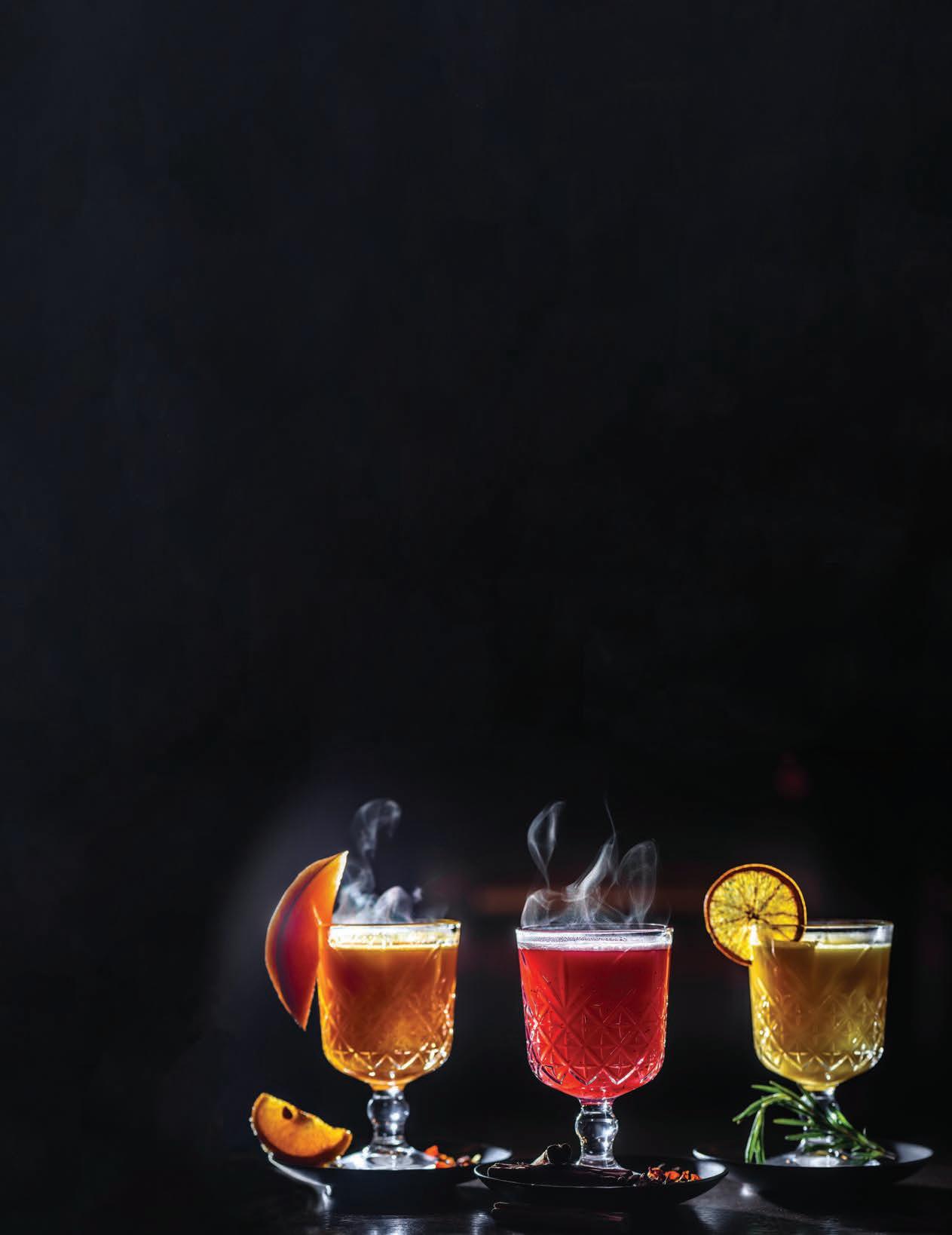
NUEVOS ENFOQUES PARA LAS BEBIDAS TRADICIONALES
Los restaurantes mexicanos y latinos, que han sido durante mucho tiempo destinos de Margaritas, Palomas y Mojitos helados, ya tienen los ingredientes y los perfiles de sabor para crear cócteles calientes atractivos.
Y sus opciones van más allá de la invención de bebidas de café caliente, según Nardelli, que dice que los cantineros pueden utilizar bebidas mexicanas tradicionales sin alcohol como punto de partida. El colega de Nardelli, Juan Martínez, por ejemplo, ha mejorado el champurrado —un atole espeso y caliente a base de chocolate hecho con masa de harina, piloncillo,
El fuego está encendido LOS CÓCTELES CALIENTES DISPARAN LAS VENTAS EN LOS BARES

Hot Chai Spice
COURTESY PERFECT PUREE Hot Apple & Orange Toddy

COURTESY PERFECT PUREE Agave Hot Toddy de Madre Oaxacan Restaurant & Mezcaleria
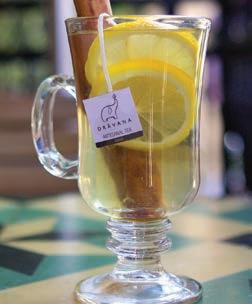
agua o leche— con Licor 43. Otro ejemplo que Nardelli ha visto aparecer en los restaurantes de Los Ángeles es el quintão, un brebaje tradicional brasileño hecho con cachaça y sidra especiada.
El ponche—un ponche de frutas caliente que se sirve durante las fiestas en México— es otro ejemplo. El chef Sergio Remolina, vicepresidente culinario de Taco Cabana en Dallas, dice que los recuerdos de su infancia cuando bebía ponche le inspiraron para crear una versión de cóctel para Taco Cabana. La versión de Remolina comienza con una base de té negro para equilibrar la dulzura que proviene de la fruta en el cóctel.
“Queríamos crear una versión del ponche que no se limitara a hablar de las festividades de la temporada navideña, sino también de las cosas que realmente son de temporada en México durante los meses de invierno”, explica Remolina. “Nuestra receta incluye guayaba, canela, cáscara de naranja, así como frutas más comunes en México, como los tejocotes (manzanas de cangrejo) y las vainas de tamarindo”.
Además del ponche de Té al Ron, Taco Cabana también ofrece Café de Olla, ambos “arraigados en las tradiciones mexicanas”, dice Remolina. “Encontrará el Café de Olla, hecho tradicionalmente en una olla de barro endulzada con piloncillo que se sirve en México durante todo el año. Ha llegado a Texas, donde se sirve durante los meses de invierno”.
“El Café de Olla también funciona muy bien por las mañanas”, añade la chef Chelsea Lietz, chef corporativa de Taco Cabana, que dice que es importante tenerlo en cuenta ya que este año la gente pasa más tiempo en casa y pide el brunch para llevar. Además de ofrecer “el aspecto reconfortante del calor”, Lietz señala que añadir ingredientes como fruta fresca y especias como lo hace Taco Cabana supone que los cócteles calientes sean “una nueva experiencia para muchos de nuestros clientes que no crecieron con las tradiciones mexicanas”.
ELECCIONES ESPIRITUOSAS
Iván Vásquez, propietario de Madre Oaxacan Restaurant & Mezcaleria de Los Ángeles, aprovecha la oportunidad de elaborar cócteles calientes que utilizan bebidas alcohólicas populares de forma creativa. Por ejemplo, el mezcal, uno de los favoritos de los clientes: Vásquez lo utiliza en su Agave Hot Toddy, un cóctel que cree que se pondrá de moda “por todo lo que lo hace diferente de otras bebidas de mezcal que se sirven ahora”.
Este cóctel decididamente “diferente” se elabora con un mezcal destilado tres veces, té que Vásquez importa de Oaxaca, además de canela, miel y una rodaja de limón. “La forma de hacer el mezcal no es demasiado ahumada [por lo que] permite que los sabores naturales del té brillen”, explica Vásquez. “También es una forma estupenda de que los clientes a los que les gusta el mezcal lo disfruten caliente, y de una forma que no han probado antes”.
Además de que el mezcal combina bien con el té, Miller, de la Bodega Taqueria y Tequila, dice que algunas ginebras y whiskies más suaves también son buenos telones de fondo para los productos botánicos con toques de cítricos. También le gustan los rones mexicanos como base, ya que abren “una ventana de sabores curiosos con los que experimentar, [así como] las notas saladas de otras botellas”.
El café caliente también combina bien con el mezcal, señala Vásquez, que dice que los miembros del personal a veces sugieren un café caliente con un trago de mezcal, tal y como se sirve en Oaxaca. “A los clientes a los que no les gusta el mezcal, podemos ofrecerles el café oaxaqueño con un chupito de tequila o whisky añadido e iniciar una conversación sobre los ingredientes de los cócteles terminados”, añade.
ALTERNATIVAS A LA CREMA
Muchos cócteles calientes — especialmente las creaciones a base de café— dependen de los productos lácteos para obtener suavidad y sabor. Pero el uso de ingredientes lácteos puede suponer un reto: no son estables y a menudo aportan un aspecto pesado que a muchos clientes ya no les gusta.
“Intentamos crear un cóctel caliente con café de Oaxaca y nuestra nata montada casera”, dice Vásquez. “Aunque el resultado final era estupendo, requería demasiado trabajo y descubrimos que la nata montada caducaba al cabo de
un día. Debido a la necesidad de mantener las cosas frescas, nuestras recetas tienen que ser más sencillas, con menos azúcar y menos pesadas”.
Y como señala Miller, las bebidas pesadas hechas con nata y alcohol suelen ser más difíciles de vender más allá del postre.
Una nueva tendencia que se está gestando en este ámbito es la de las alternativas lácteas de origen vegetal.
En Sobre Mesa, en Oakland (California), por ejemplo, el cóctel Cremosa de Cacao combina ron especiado, vino tinto, licor de batata, chocolate, malvavisco tostado, jengibre y crema de coco [no láctea].
CONCENTRADOS, INFUSIONES Y ESPECIAS
Para los bares que quieren conciliar calidad y comodidad en sus ofertas para llevar, Miller sugiere preparar un concentrado de té para hacer su sirope y simplemente introducir agua a menor temperatura en el cóctel. “Esto garantiza que no se sobrecaliente la bebida espirituosa, y resulte demasiado desagradable para el olfato a causa de los vapores, a la vez que se incorporan los sabores del té”, afirma.
Dado que la disponibilidad y el coste de los ingredientes frescos también son una cuestión importante, algunos establecimientos están recurriendo a los cordiales, los jarabes ácidos y los purés de frutas estables para crear productos de temporada, sobre todo en una época en la que las bebidas para llevar son lo más habitual. Nardelli afirma que las bebidas espirituosas con infusión de té y los ingredientes a base de té son cada vez más habituales para conseguir cócteles con sabores frescos, ya sean calientes o fríos.
“Hay mucha versatilidad cuando se introducen infusiones en licores básicos”, explica Nardelli. “Se pueden infusionar 20 botellas de tequila con diferentes tés, añadir zumo de lima y tener como resultado 20 cócteles diferentes, incluidos algunos que saben mejor calentados”.
Según Remolina, los consumidores preocupados por la salud se orientan hacia combinaciones de especias más interesantes. “Además de la canela, hablamos de anís estrellado, cardamomo, pimientas y otras especias que nos calientan”, dice.
CONSEJOS DE MÁRKETING
Aunque haya muchos clientes curiosos que busquen algo nuevo, habrá otros que duden en salir de su fría zona de confort. Los que predican las maravillas del cóctel caliente tienen algunas estrategias eficaces para conseguir que esos clientes se aficionen al concepto.
Fomentar los cócteles calientes en los menús del brunch es una de las opciones, según el chef Lietz de Taco Cabana, que afirma que están en consonancia con el retorno de la popularidad de los cócteles matutinos o del brunch, especialmente cuando el frío invernal persiste en algunos lugares.
Hacer que los nombres de las bebidas sean “impresionantes y pegadizos” es otro punto a favor, dice Nardelli. “Además, dado que el año pasado todo el mundo ha pasado mucho tiempo en casa, la idea de estar fuera y tomar esa bebida caliente servida en un vaso fresco o con una historia de fondo memorable hará que la gente quiera pedirla”, añade.
Presentar los cócteles calientes como “especial del día” también puede ayudar.
“Asegúrese de tener toda la información sobre los cócteles calientes habituales y los especiales en sus menús en línea para captar su atención”, dice Hinojosa. “Cuando los clientes acudan al restaurante, anímeles a probar estos cócteles y explíqueles lo que hace que el especial del día sea realmente especial. Me gusta llamar a los cócteles calientes ‘tapas de noche’, ya que pueden poner fin a una comida y a una velada, dentro o fuera del local, con una nota acogedora, con una mayor belleza gracias a la mezcla de frutas, tés, especias y licores. Además de los cítricos, que siempre son ingredientes imprescindibles para los cócteles mexicanos, se puede mantener el interés durante todo el año con duraznos, cerezas, bayas y otras frutas, en formas estables como el puré, por supuesto”.
UNA INTRODUCCIÓN A LA PREPARACIÓN DE CÓCTELES PARA LLEVAR
Ahora que los cócteles para llevar se están volviendo una forma de vida para los restaurantes en esta época de covid, es importante saber cómo preparar y envasar mejor todos los ingredientes del cóctel. Aquí, Manny Hinojosa, embajador global de marca de Tequila Cazadores y Tequila Corzo, explica cómo hacer que la experiencia sea segura y sabrosa para los clientes que piden cócteles calientes para consumir en casa.
“Hay que envasar la bebida para los pedidos para llevar con dos envases diferentes. Uno contendrá los ingredientes con alcohol, como el tequila, el ron o el whisky de base, junto con otras bebidas alcohólicas o licores. El otro contendrá las partes no alcohólicas de la mezcla”, dice Hinojosa. “Proporcione al cliente instrucciones verbales e impresas, en las que se le advierta que no debe calentar el alcohol. Lo único que debe recalentarse es la mezcla en una taza de café apta para microondas, y solo durante el tiempo indicado en las instrucciones. Después de unos 30 segundos, el cliente puede añadir la porción de licor y disfrutar”.
Vea las recetas de cócteles calientes a partir de la página 53.




